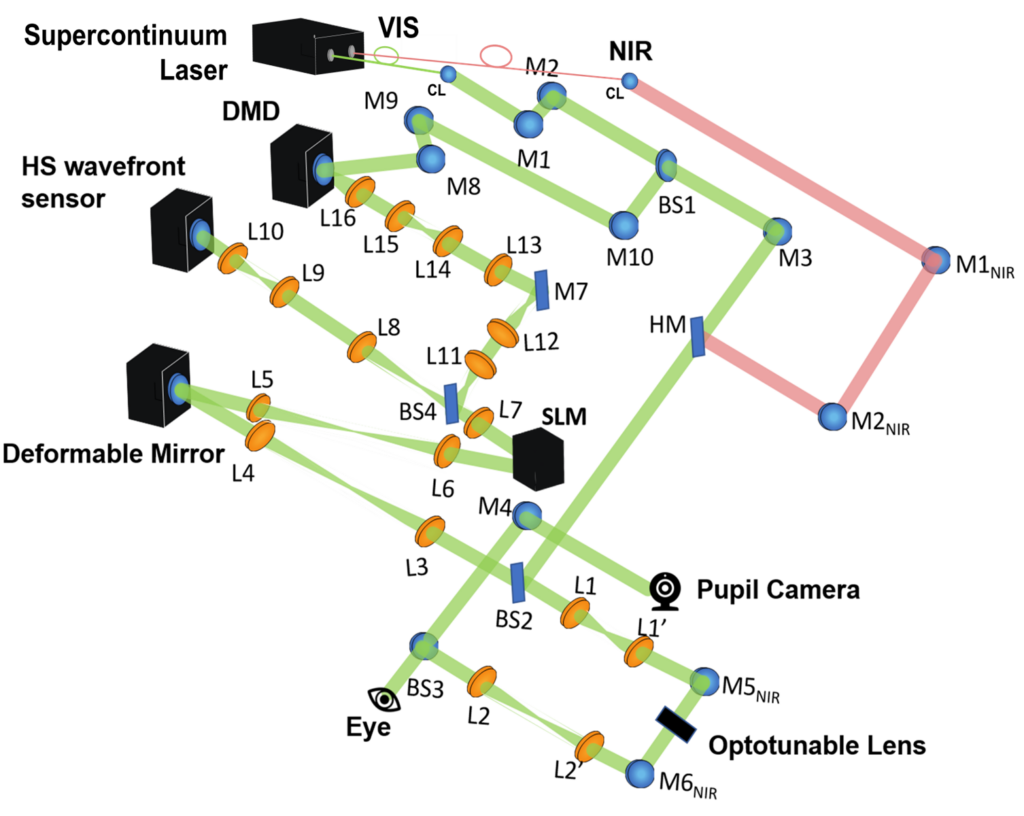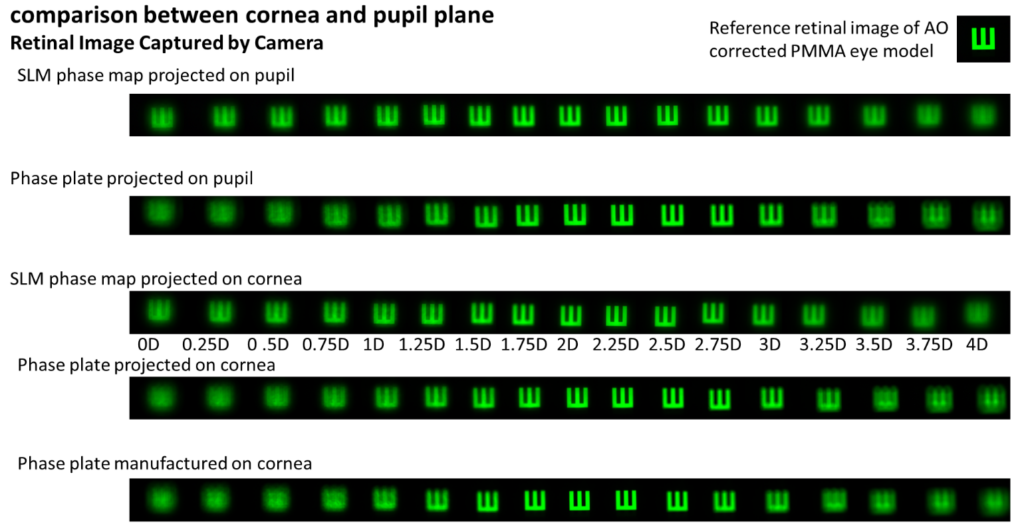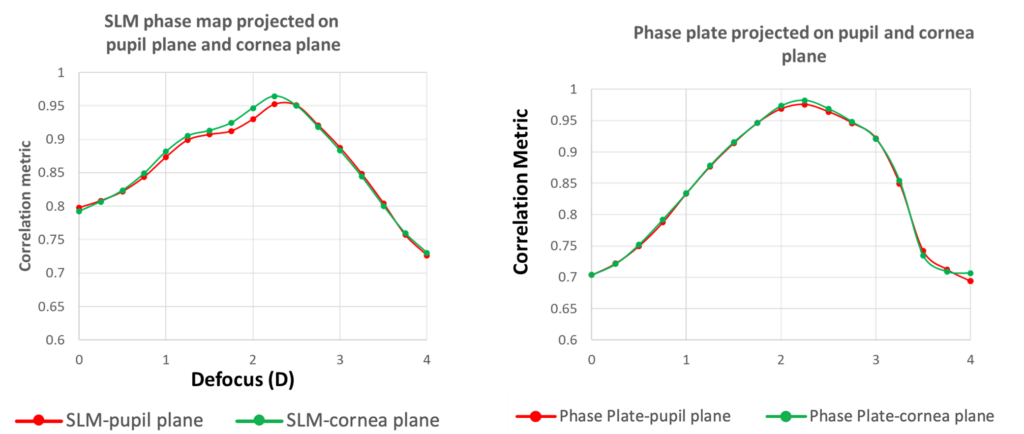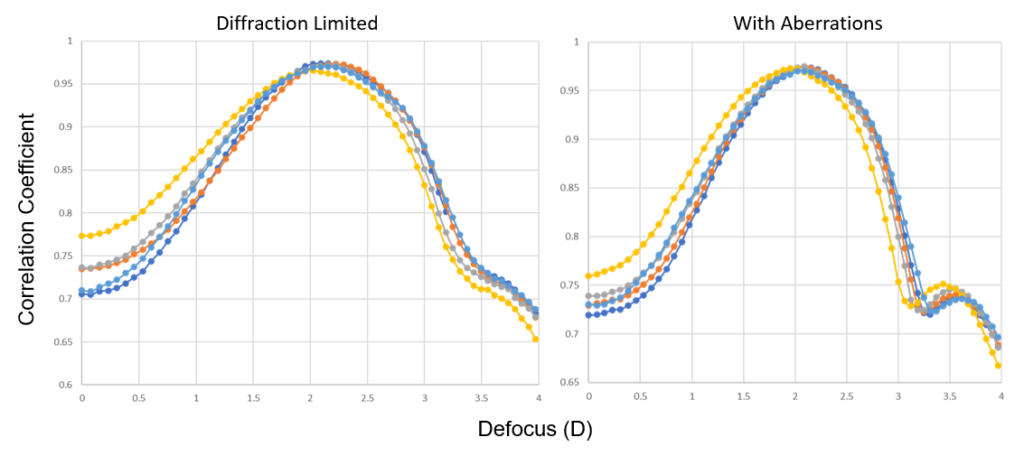Author
Ellen Jiang
Mentor
Susana Marcos
This project is done in collaboration with the Center for Vision Science and Bausch & Lomb
Abstract
Bifocal and multifocal contact lenses are industry-leading solutions for presbyopia, which affects nearly 90% of adults over 45. The current process to design and prototype one of these novel lenses requires precision machining and is limited by human perceptive error. The work in this thesis serves to evaluate a new method to simulate contact lens profiles, provided by Bausch & Lomb, using an adaptive optics visual simulator and a camera mirroring the optical qualities of the eye in lieu of human subjects, as well as propose image quality metrics to evaluate the corrective nature and clarity of the simulated contact lens profiles.
Imaging Setup Using AO Visual Simulator

An adaptive optics visual simulator is used to simulate the user’s experience of wearing a contact lens. The one used in this study has three different variants of adaptive wavefront manipulation:
- Deformable Mirror – While it is used in the system to correct aberrations and produce diffraction-limited images, it can also be used to induce aberrations that mimic those of the human eye.
- Spatial Light Modulator – Used to simulate the power profile of the contact lens.
- Optotunable lens – Induces various vergences of defocus to allow for a range of through-focus imaging.
The adaptive optics visual simulator used was initially designed to be used with human patients, but this study uses a camera setup that mimics the anatomy of the eye.

AO system validation
Before proceeding, the AO visual simulator’s ability to mimic the effects of real multifocal contact lenses and current lens prototyping standards was evaluated. The goal is to compare between the theoretical lens profile induced by the spatial light modulator, an intraocular lens phase plate, and a version of the artificial eye with the lens profile lathed onto the “cornea,” similar to how lenses are worn by patients. To do this, through-focus images of a letter E stimulus are taken with each “lens” in the system and correlated to a diffraction limited “ground truth” image, indicating where the image is properly in focus and how focused it is. With this, we can conclude that the visual simulator does accurately induce the desired power profiles of the lenses.


Image Metric: Correlation
Similar to how the system was validated, through-focus images of the letter E stimulus were taken through tested lens profiles and the correlation curves were compared against each other. As multifocal lenses often have regions of varying amounts of refractive add to account for near and distance viewing, the combined effect leads to an increase in the depth of focus on the retina, as seen in the correlation plot below. This was also repeated with visual aberrations induced in the artificial eye, which resulted in a slight uptick in focal quality at the near viewing condition.

Image Correlation: Contrast Sensitivity

To evaluate how the lens profiles affected contrast sensitivity, through focus images of each of the above gratings were taken and contrast across the grating was calculated. Observing how contrast changes through-focus allows us to see how depth of focus changes for different spatial frequencies, and seeing how contrast changes at best focus in relation to the spatial frequency of the grating produces a plot that can best be simplified as the Optical Transfer Function of the lens. As with the correlation metric, this test was performed for a diffraction limited case as well as two aberrated, human eye wavefronts (a low aberrated add and a high aberrated add).

Conclusions & Further Work
The AO system does serve as a substitute for traditional multifocal contact lenses. Using through-focus correlation and contrast sensitivity, we can qualitatively & quantitatively see how these lenses affect visual quality and depth of focus in both diffraction limited and aberrated imaging. Further work is currently being done to develop pattern preference image metric and explore the halo effect caused by these lenses when imaging a point source, as well as using the currently proposed image metrics to create a quantitative index that can be used for ranking and “grading” newer contact lens prototypes. In the future, a more rigorous exploration of how individual aberrations affect the perceived visual quality through different lens profiles may also be valuable.
Acknowledgements
Funding, multifocal lens profiles for testing, specially machined parts, and patient aberration database provided by Bausch & Lomb.
I’d also like to give special acknowledgement first and foremost to my advisor, Dr. Susana Marcos and Professor Wayne Knox, for his guidance as the Senior Thesis course coordinator. I also extend my thanks to Alex Kotelsky and Joshua Slane of Bausch & Lomb, and Tianlun Zuo and Sabya Goswami of the Marcos Lab. Last but not least, I’d like to thank you (yes, you) for reading up to this point. Thank you :)
References
Vinas M, Dorronsoro C, Radhakrishnan A, Benedi-Garcia C, LaVilla EA, Schwiegerling J, Marcos S. Comparison of vision through surface modulated and spatial light modulated multifocal optics. Biomed Opt Express. 2017 Mar 3;8(4):2055-2068. doi: 10.1364/BOE.8.002055. PMID: 28736655; PMCID: PMC5516828.
Vedhakrishnan S, Vinas M, Aissati S, Marcos S. Vision with spatial light modulator simulating multifocal contact lenses in an adaptive optics system. Biomed Opt Express. 2021 Apr 21;12(5):2859-2872. doi: 10.1364/BOE.419680. PMID: 34123507; PMCID: PMC8176799.
Vedhakrishnan S, Vinas M, Benedi-Garcia C, Casado P, Marcos S. Visual performance with multifocal lenses in young adults and presbyopes. PLoS One. 2022 Mar 17;17(3):e0263659. doi: 10.1371/journal.pone.0263659. PMID: 35298476; PMCID: PMC8929584.
Walline, J. J., Walker, M. K., Mutti, D. O., Jones-Jordan, L. A., Sinnott, L. T., Amber Gaume Giannoni, … Berntsen, D. A. (2020). Effect of High Add Power, Medium Add Power, or Single-Vision Contact Lenses on Myopia Progression in Children. JAMA, 324(6), 571–571. https://doi.org/10.1001/jama.2020.10834
